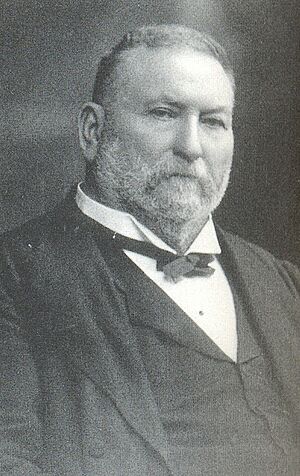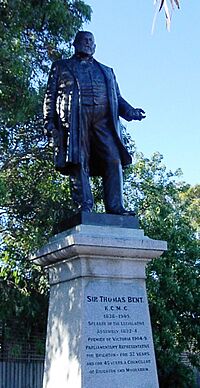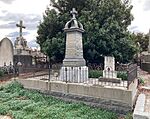Thomas Bent facts for kids
Quick facts for kids
Sir Thomas Bent
|
|
|---|---|
 |
|
| 22nd Premier of Victoria | |
| In office 16 February 1904 – 8 January 1909 |
|
| Preceded by | William Irvine |
| Succeeded by | John Murray |
| 6th Speaker of the Victorian Legislative Assembly | |
| In office 11 May 1892 – September 1894 |
|
| Preceded by | Matthew Davies |
| Succeeded by | Graham Berry |
| Member of the Victorian Legislative Assembly for Brighton |
|
| In office 1 November 1900 – 17 September 1909 |
|
| Preceded by | William Moule |
| Succeeded by | Oswald Snowball |
| In office 16 March 1871 – 4 September 1894 |
|
| Preceded by | George Higinbotham |
| Succeeded by | William Moule |
| Personal details | |
| Born | 7 December 1838 Penrith, New South Wales |
| Died | 17 September 1909 (aged 70) Brighton, Victoria |
| Resting place | Brighton General Cemetery |
| Nationality | British subject |
| Spouse | Hannah Hall & Elizabeth Huntly |
| Occupation | Land speculator and developer |
Sir Thomas Bent (7 December 1838 – 17 September 1909) was an important Australian politician. He served as the 22nd premier of Victoria, which is like being the leader of the state government.
Contents
Early Life and Local Leadership
Thomas Bent was born in Penrith, New South Wales in 1838. He was the oldest of four sons and two daughters. His father was a hotel owner. In 1849, his family moved to Melbourne.
He went to school in Fitzroy, a suburb of Melbourne. Later, he became a market-gardener in Brighton East. In 1861, he started working for the town council of Brighton. Brighton was a fast-growing area at that time.
Thomas Bent soon began buying and selling land in Brighton. He became a property developer, creating new areas for homes. One new area, Bentleigh, was even named after him. He was a member of both the Brighton and Moorabbin town councils. He was also the Mayor of Brighton nine times!
Joining State Politics
In 1871, Thomas Bent was elected to the Victorian Legislative Assembly. This is like being a member of the state parliament. He represented the Brighton district. People were surprised because he defeated a well-known politician, George Higinbotham.
Bent did not have strong ties to one political party. He first held a government job in 1880. From 1881 to 1883, he was in charge of Public Works and Railways. He used this position to extend a railway line. This railway line went from Caulfield to Cheltenham. This greatly increased the value of his own land developments nearby. People started to question his business dealings because of this.
After these events, Bent spent 18 years as a regular member of parliament. He focused on his property businesses. He faced some financial difficulties in 1888. However, he soon recovered and became a big player in the "Land Boom" of the late 1880s. For example, he bought property for £1,488 and sold it the same day for £2,000.
In 1892, he became the Speaker of the Assembly. This was part of a political agreement. Some people made fun of him because he spoke with a strong Australian accent. They thought he was not as refined as other politicians.
When the Land Boom ended, Bent faced serious money troubles. He had large debts. He lost his seat in parliament for Brighton in 1894. This happened after a newspaper published letters he wrote as Railways Minister. These letters seemed to offer railway lines to politicians if they voted for certain things.
Return to Politics and Premier
Thomas Bent moved to Port Fairy with his wife and two daughters. He started dairy farming there. But he still wanted to be involved in politics. After trying to get elected in Port Fairy, he moved back to Melbourne in 1900. He was re-elected for Brighton in November 1900.
He made a big comeback by becoming the Minister for Railways again. This was in William Irvine's government. He again faced questions about his land dealings. He bought land in Brighton, then approved a tramline that went right past his properties.
Despite the questions about his past, Bent was chosen as the new leader of the Liberal Party in Victoria. This happened when William Irvine left state politics in 1904. So, at 66 years old, Thomas Bent became the Premier of Victoria.
By this time, Bent was quite large and had a friendly personality. Victoria was also recovering from a tough economic time. This made him popular again. As Premier, he also managed public works and railways. His government passed many laws. These laws helped improve public health, education, and old age pensions. They also worked on saving water.
He won elections easily in 1904 and 1907. His government believed the state should be more involved in the economy. They also agreed that high taxes on imported goods were needed to protect Victorian businesses. Bent was proud that he brought stability and wealth back to Victoria.
However, in 1908, his government started to have problems. There were disagreements between politicians representing country areas and those representing cities. A group of country members, led by John Murray, opposed one of Bent's bills. To make them happy, Bent withdrew the bill. He also gave some of Murray's supporters jobs in his government. But this upset other politicians from Melbourne, led by William Watt. In January 1909, these groups joined together to defeat Bent in the Assembly. Bent resigned, and John Murray became the new Premier.
Sir Thomas Bent's Legacy
Sir Thomas Bent passed away on 17 September 1909 at his home in Brighton. In 1908, he had been made a Knight Commander of the Order of St Michael and St George (KCMG). This is a special honor. He had a state funeral and was buried in Brighton General Cemetery. He was married twice, first to Hannah Hall and then to Elizabeth Huntley. Most of his money went to his daughter from his second marriage.
A statue of Thomas Bent was put up in 1913 in Brighton. People paid for it through donations. For many years, "Tommy Bent's statue" was a famous landmark in Melbourne. During the Victorian Football League grand final, people would often put a cap and scarf on the statue. These would be in the colors of the winning team. In the 1960s, people sometimes threw white paint on the statue as a prank. In the 1970s, the highway was made wider. The statue was moved to a less noticeable spot. Because of this, it is not as well-known a landmark today.



